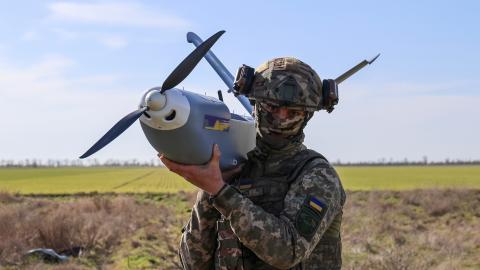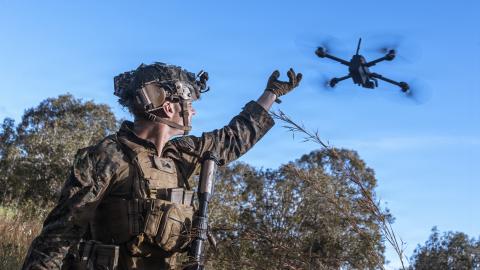
In-person attendance is by invitation only. The event will also air live on this page.
Inquiries: [email protected].
Building Weapons that Adapt and Scale

In-person attendance is by invitation only. The event will also air live on this page.
Inquiries: [email protected].

Senior Materiel Leader, Air Force Materiel Command

Vice President for Air Dominance and Strike, Anduril Industries

Head, General Atomics Electromagnetic Systems Weapons Programs

Program Manager, Defense Innovation Unit

Vice President, Business Development, Space, Intelligence, and Weapon Systems at Boeing

Senior Fellow and Director, Center for Defense Concepts and Technology
Bryan Clark is a senior fellow at Hudson Institute. He is an expert in naval operations, electronic warfare, autonomous systems, military competitions, and wargaming.
The war in Ukraine and the United States’ operation to defend shipping against Houthi attacks in the Red Sea highlight how weapons inventories can make the difference between deterring aggression and losing a war. But the US military’s munitions portfolio is weighted toward sophisticated missiles whose tightly integrated designs and bespoke supply chains cannot be produced—or modified—at the pace modern conflict demands. As a result, current operations are depleting the magazines US forces will need in a potential confrontation against China.
But today’s conflicts also demonstrate that a new generation of less-sophisticated missiles and drone/missile hybrids is increasingly effective on the modern battlefield. The proliferation of advanced software and commercial microelectronics has helped enable Houthi rebels and Ukraine’s defenders to stress or overcome more capable adversaries. The US military could exploit these same innovations to field a new family of munitions that can provide scale and adaptability and complement the lethality and reach of its most capable weapons.
Join Hudson Senior Fellow Bryan Clark for a discussion of the opportunities and challenges in establishing a new weapons design and development approach with leaders from the US Air Force, Defense Innovation Unit, and US defense industry.
In-person attendance is by invitation only. The event will also air live on this page.
Episode Transcript
This transcription is automatically generated and edited lightly for accuracy. Please excuse any errors.
Bryan Clark:
All right. Well, thank you all for being here. Welcome to the Hudson Institute. I’m Bryan Clark, I’m a senior fellow here at Hudson. I’m also the director of the Center for Defense Concepts and Technology here at Hudson.
We appreciate you taking the time out of your day to come in and chat with us a little bit about how do we expand the adaptability and scale of our weapons portfolio in DoD. And for that discussion, we’ve got a terrific panel with us of people who are working in this area right now, trying to come up with ways for the DoD to field a more flexible and larger weapons and munitions magazine in the future.
So, I’ll start on the very far left over there. Eric Nelson, who is the vice president for Business Development and Strategy, Space, Intelligence and Weapon Systems at Boeing. So, thank you very much, Eric, for being here. Next to him is Diem Salmon, who is the vice president for Air Dominance and Strike at Anduril Industries. And thank you very much, Diem, for being here. Next to her, Tim Fuhrman, Colonel Tim Fuhrman is the senior material leader at Air Force Materiel Command, but he’s essentially the program manager for the Adaptive Weapons Program. So, to make a little more colloquial way of describing it. Next to him is Trent Emeneker from Defense Innovation Unit where he’s the Autonomy Portfolio program manager. So, thank you very much, Trent, for being here. And then last but not least, Mike Rucker is here from General Atomics Electromagnetic Systems, where he is the head of Weapons Programs at General Atomics, EMS. So, thank you very much for being here, Mike.
Well, so the focus of our discussion is, to be a little bit self-promoting for a minute, this lovely report that we recently published here at Hudson looking at how do we expand the adaptability and scale of the US weapons portfolio? So, Ending Self-Imposed Scarcity: Exploiting America’s Commercial Strengths to Mobilize Weapons Production.
And the report really gets at this idea of going back to Freedom’s Forge, going back to World War II, how did we mobilize the US economy to be able to support the weapons systems we needed at the scale we needed for the war? And that really meant tapping into other sources of production beyond the traditional defense industrial base. So, we had Ford building aircraft, we had people who build Whirlpool, they were building dishwashers one month, next month they’re building a weapons system. So, mobilizing parts of the industrial base that aren’t traditionally thought of as being part of the defense industrial base is key to being able to get to that scale, and also coming up with ways to become more adaptive through things like modular design.
So, how are you all pursuing that goal of adaptability and scale and weapons production? And you’re looking at it from different directions, obviously some of you are in government, some of you are in industry. And I’m just interested in at first, what’s your general approach to how do you achieve adaptability and scale? And so, we’ll just start here with Mike from General Atomics on the right-hand side.
Mike Rucker:
Yeah. I think the best example I can give is this long-range moving projectile program, which is actually mentioned in the paper. It’s an IRAD design, but what we’re looking at from a gun-launched munition is to look at sub-components and compartmentalizing interfaces so that we can, in a surge situation, we’re already talking to international partners because this is a 155 launch munition, how could we do some of this overseas? And if we do things overseas, we can’t export everything that could be possibly in this munition. So, having standard interfaces and things that potentially international partners could do is one of the focuses of the design.
The other thing from a manufacturing perspective is that we have even during the IRAD effort, set up manufacturing cells so we can figure out what’s our throughput from a manufacturing capability? How many machines do we need to complete the machining? What kind of automation between each one? And then we can determine this cell has a throughput of 200 munitions a month. So, if we need to ramp up to do 100,000 a year and we know with our international partners and ourselves we need this many cells in order to do it. So, we’re getting metrics during the development phase to look at scalability and partnering at that level.
Bryan Clark:
And so, adaptability is something you mentioned or the modularity that comes with that design paradigm, gives you that ability to become more adaptable, which I think we’re finding in Ukraine, having more adaptable weapons portfolio is essential because they’re having to adjust on a weekly, if not daily basis, how they pursue their objectives because of the electromagnetic environment-
Mike Rucker:
Exactly.
Bryan Clark:
... because of the challenges of different force compositions that the Russians are deploying.
Mike Rucker:
Yes. So, one of the things we’ve done in this long-ranging projectile is from a seeker perspective, making sure that the seeker technology is got an interface to our onboard electronics and our processing units. So, if we have to swap out what the end game is going to be, it’s not tightly coupled with the sensor itself. The processing is actually, the navigation is separated to allow for those kind of changes.
Bryan Clark:
So, Trent, from DIU’s perspective, you guys are focused on how do I take advantage of a commercial or available technology and translate that into something that’s militarily relevant? How are you pursuing that in the weapons portfolio where it’s maybe not completely intuitive for people what in the commercial sphere is relevant to a military operation?
Trent Emeneker:
Yeah. Well first, Bryan, thanks to you and to Hudson for the chance to come today. So, when you’re thinking about adaptability and scale, scale comes from the commercial sector, period. That is where our manufacturing capacity is. It’s where our innovation comes from. It’s where we can 10X or 100X or 1000X, but we just can’t do that with a solely defense-focused ecosystem. Our budgets aren’t large enough, the infrastructure’s not there. 99.9% of the time you don’t need it.
So, when we think about adaptability, one, I would say the general approach that we have is we recognize that uncrewed systems have changed the way wars are fought like nothing since the machine gun more than a century ago. And if you look back at World War I, and as we see again today in Ukraine, battle lines have stabilized, they’ve almost solidified. Continual iteration and tactics though, because if you look at what uncrewed systems have done there every three months you can point to things are different, still uncrewed, but things are different. And so, how do you succeed in that environment?
Well, it’s very much a nontraditional government contracting approach. You have to trust your commercial partners, you have to hold them accountable, and you have to iterate and you have to do it overnight. So, what we see is the model that works is companies and their engineering teams are embedded directly with the warfighter on the front lines, at operations, in combat. They take that learned feedback and they send it back overnight to the larger engineering team.
Everyone in here has probably seen Office Space, the guy who takes the piece of paper from the engineer to the customer. You have to do that and then you have to send a solution back and it’s not going to be perfect, but it’s going to be better. And if it’s not better, then you identify what doesn’t work. It’s the Silicon Valley model of software development, go fast, release, update, and improve. And that’s the conceptual framework that we try and bring, look for, and act on at DIU. The kinetic piece is, to be fair, new to us. We don’t approve kinetics, we don’t do that, but we want to provide the tools so that off the shelf you can take the drone or the long-range, one-way attack platform and then you can put kinetics in, leave that up to the warfighter, but that’s what we’re looking to do.
Bryan Clark:
Yeah. So, Trent, what that kind of makes me think about is that what you’re bringing in is the commercial model of technology adoption rather than a commercial off-the-shelf technology. So, there’s obviously not lethal UAS, hopefully, sitting on the shelf over at some commercial provider, but instead it’s this DevOps type of approach that you’re applying to it, which may be a source of advantage if we can do it right. It seems like even against an opponent like a China that’s very capable, if they can’t iterate at the same pace we’re able to, then maybe that does offer an edge.
Trent Emeneker:
Yeah, I agree. I think Silicon Valley is our secret weapon. When we unleash American capitalism and what our software and tech industry can do, we can turn cycles around anybody we want. Now, we have to do it, but I can point you to if the Blue UAS List, which is one of the projects I lead, we partner with a small but agile team at the Marine Corps Warfighting Lab. 10 months later, after directly partnering with commercial industry, we added the Neros Archer to the Blue UAS List, the first FPV on the list, it is kinetic capable. The Marine Corps is doing limited kinetic experiments now with it, on track for a full approval in the next couple of months for that.
If you look at what a traditional Program of Record timeframe is, 10 years, that’s about the timeframe. And so, in 10 months by partnering with industry and moving fast and accepting risk, we delivered a capability for the warfighter today and it’s cheap and they take lessons learned from Ukraine. Now, this was a commercially-driven success. We’re not taking credit for it, but we collaborated with them to get to where we needed to go.
Bryan Clark:
So, Tim, when we look at this model and thinking about how the Air Force is trying to bring in this more adaptable approach to weapons development and maybe some commercial technology and at least a commercial mindset for how do you develop it, how does that translate into programs like ERAM, which you guys are working on, which is modular weapons system?
Tim Fuhrman:
Yeah, it translates really well. The key, I think there’s just prerequisites that you have to have going into this, and both these gentleman talked about interface, standardizations, scaling. What I would say also to add to that is making sure that your designs up front are clean enough that you can actually do that work in a non-invasive, like where you have to go back in time, big time.
We prescribe at Eglin Air Force Base, the use of a weapons open systems architecture and a government reference architecture. And I think that that communicates well to broad audiences both within the traditional DIB, but what we’re finding is more interaction with the commercial sector on that specification so that we don’t bound ourselves in the design features, whether that’s the way that the missile, the projectile needs to communicate or not.
So, certainly we are looking at the opportunity to pull in more vendors. Specific to ERAM, it’s allowed that particular company, one of those vendors to actually take what they were working on on our affordable mass, our Family of Affordable Mass Missiles, FAMM, and easily make an adaptation so that it can be lug launched to support the Ukraine effort. So, I mean therein lies the power of a clean design, quick design, and being able to certify to it quickly.
A lot of this we’re still in the prototyping phase, so to say I have a clear example of scalability, I’d be lying if I said, “Hey, I have the thing that’s happening.” What we have is demonstrated sufficiency that gives us confidence to move into the manufacturing realm. So, I’d like to echo thanks for the invite here and I look forward to future discussion especially on the manufacturing side. You bet.
Bryan Clark:
Thanks, Carl. So, Diem, how is Anduril pursuing this from the industry side, right? So, you have developed a series of weapons, Barracuda, Fury, with the CCA program under the Air Force. How do you align what you’re doing internally with what the government may want in terms of architectures and performance characteristics?
Diem Salmon:
Right. Yeah. And I think we’re perfectly aligned on the actual priorities of where, when we think about weapons or missiles in DoD in the future, what are the problems that we actually need to solve? Right? And it’s like scalability, manufacturing at rate. This has been kind of the hurdle that most of the DIB has had for the past decade, right? And so, when Anduril decided to go down this pursuit of getting into the weapons space, that was the problem we keyed in on. It doesn’t matter if I can make a missile that is 10% greater in range, right? It matters if I can produce it at scale and that it’s adaptable. This is what we’ve learned in the past several years, technology’s changing a lot faster than programs and the department can adapt to. So, if you actually bring in that flexibility in the beginning, you’re designed to be more relevant in the future.
And the way we’ve manifested this is it happens at the beginning in your design phase. So, you have to design for scalability and manufacturability and you have to design for adaptability. So, being WOSA compliant and GRA compliant is a day one requirement for any design that you’re doing. And understanding your objective in terms of manufacturing at scale is something that needs to be considered in day one design.
A great example of this is the ETV effort with DIU where manufacturing was a very clear priority for the program and a requirement that was put on design. So, rather than thinking through traditional means of manufacturing, like, composites, right? We had to think through if we needed to surge manufacturing very quickly or we needed to do this at rates closer to the thousands, not the hundreds, how do we do this? And it is leveraging commercial manufacturing. You cannot do this within your traditional defense manufacturing base.
And so, the engineers have to think through and bring into the design what are the commercial manufacturing capabilities resident in the United States that we can leverage? And a great example of this is we use fiberglass in our air vehicle, right? Because that is a commercial feature and that gives us the ability to scale. There’s always trades, there are no free launches in design, right? We all know this. And so, that’s something that you have to work very closely with government on and making these decisions. But I think, and one of the reasons why I think this panel is so perfectly timed, there’s a complete alignment right now both within the DoD and with industry and understanding how to solve this problem.
Bryan Clark:
We’ll get into, I think with the design trades and how do you manage a program to be able to maximize scalability and timeliness, I think that’s something we’re definitely going to want to get into.
Eric, one thing I wanted to ask is, obviously Boeing has been doing weapons for a long time and there’s examples of modular weapons that are in our portfolio now that were fielded in generations past in some cases.
Eric Nelson:
Yes.
Bryan Clark:
How do we make those relevant for the current environment, so some of these systems like JDAM? That Boeing’s-
Eric Nelson:
That’s a great question, Bryan. And thanks to Hudson for hosting us today. Just for you that don’t maybe track Boeing’s weapons portfolio, JDAM, Joint Direct Attack Munition, been around since 1998. We’ve made over 550,000 of them. At one point our highest rate of production per year was 55,000, which meant we were doing five JDAMs off of the line per minute.
So, just think about that for a moment. A lot of discussion here, a lot of interesting ideas and we’ve had to adapt this weapon system over time. The beauty of the modular design of this tail kit, for instance, is it’s adapting to a cast iron bomb. You’re, by design, creating a modular break between the missile body or the weapon body and its guidance system, which was phenomenal for us because over time you’re able to insert new upgrades to both the INS, the NAV system, GPS, you’re able to change crypto at the speed of your production. So, if you need to iterate on new chips, new chips design, new crypto, different types of GPS modes and receivers from different levels to include up into M-code, it gives you a lot of flexibility to do that across the board.
And what we found in getting that supply chain was essentially we have a 75% of our supply chain is in small and medium-sized businesses. That allows us to partner with new and innovative companies that are coming in on new technologies and capabilities. There’s all types of alternate navigation going on given the electromagnetic environment, very interesting to innovate, but it also gives us a chance to incorporate international partners. So, on our JDAM-ER or extended range, think about the traditional JDAM is just cast iron bomb with the tail kit for precision nav and guidance. Extended ranges add wings. Literally, you just get more range because you get more lift over time. Our international partner is in Australia providing those wing kits.
And then the third iteration of that modular weapon is essentially adding a low-cost turbine. So, essentially all you’re getting is just an added range and a little step-up over time. But what we found is really helpful for us is just literally the decades of lessons learned on production and capacity and wringing out every bit of Lean and Six Sigma in that speed. I love the commercial idea, waterfall versus agile. Agile every day. Help needed culture versus I’m blocked. 100%. There’s so many things that a lot of traditional companies are applying in this area, which are just magnificent, very commercially oriented.
But I’d say it’s given us a way to innovate much faster than I think you normally would’ve. And it comes back down to what you mentioned, the design at the beginning allowed for the most flexibility. Build up a kit wherever you are, send it. And the flexibility of bifurcating the warhead and the explosives from the actual design was ... I’m not sure we really resonated with it at the time, but one of the key limiting factors in building a weapons system is something called net explosive weight. That’s essentially how much munitions you can store and how many bunkers and how large of a safety radius you need. So, one thing to consider as we start to scale is where will these weapons be stored up until the time they’re used? Because by putting them in a large place, you have to have a lot of distance around those locations from a safety perspective.
So, I think that’s one wonderful element of our JDAM narrative is that it’s very scalable and it’s kind of bifurcated and allows for a lot more innovation to occur in the parts that change the most frequently, in the electronics, the chipsets, crypto, comms, things of that nature.
Bryan Clark:
And that’s something you talked about with Blue UAS also, is that we’ve decoupled the explosive, the warhead from the rest of the vehicle.
So, let’s talk a little bit about the design space for these weapons and how that needs to change, because several of you have talked about the idea that to be able to get to scale, you might need to make some trades in terms of performance or other characteristics, which sort of implies that we’re shifting the design paradigm from the Cold War model of we’re going to squeeze the most performance as possible out of this weapon, which means it needs to be maybe highly integrated, it’s going to have a lot of specialized components, it won’t have a very deep supply chain, which makes it difficult to scale but makes it very capable. It seems like what you’re arguing is that we’re going to shift to a model where performance becomes basically the trade space, and now time to reach a certain scale, time to be able to get it in the field is much more of a paramount importance, which it’s a totally different version of the iron triangle of program management.
So, Tim, do you want to talk about how you guys think about this? How do you figure out what’s good enough, right? Because a lot of cases that requirement gets thrown over the transom from the warfighter and you have to decide, “How do I go about meeting this?” But it seems like what you and Trent are arguing is you might have to go back to the warfighter and say, “Here’s what we can do. Can you make that work?”
Tim Fuhrman:
Yeah. It starts with a deep relationship with the user, 100%. So, to get the user to understand that we need to get out of the business of system requirement specification level interaction, we need to allow industry the space to be able to do that. Really what we need to be focused on or we try to limit it to maybe three to four top-tier requirements and we try to keep them very performance oriented.
One of our requirements though, admittedly, on ETV FAMM is a cost point. We want to pressurize the industrial base and we want to give them very, very difficult things to accomplish and we think that they can do it. So, we trade off ... I mean, there’s a trade-off on range, there’s always a discussion relative to lethality. There’s always a discussion relative to how in this case for ETV FAMM, we want network collaborative, but do we need that in the first go of the weapon? No, we do not. We’re willing to trade that off. Do we need it provisioned for in design? Absolutely.
So, there’s just some, what we call tier-one requirements or the primary requirements that are non-tradable. But the psychology of that discussion I think is more important than anything else. So, because that’s not traditionally the way our users are programmed, a lot of that derives from WEPTAC, the weapons tactical school, the weaponeering side, where they want something very, very specific and sometimes that drives you to a point solution that’s counterproductive and unhealthy.
So, bringing that, what I would say the human terrain along with understanding what you could do in a timely manner, in a relevant manner, has really gained a lot of, lot of traction in the last, I would say, two and a half years. And some of that’s education, Bryan, and just making sure that the warfighter, the user understands what is out in industry. They are nose down trying to solve very hard operational problems and they don’t have the opportunity to interact with the commercial or the traditional industrial base.
Bryan Clark:
So, is it difficult in the Air Force to find who that representative of the operational community is going to be? I know from my experience in the Navy, it’s always difficult to say, well, who is going to be the customer that I’m going to interact with to have this negotiation? Because there’s a lot of stakeholders out there who might think of themselves as being the user community advocate.
Tim Fuhrman:
Sure. Right. Not so much in the weapons community. I mean, I didn’t find it ... I’d never done weapons until I arrived at Eglin in 2022. I had not done weapons in my career. I’ve been on strike platforms, but just never weapon acquisitions. It’s a pretty tight-knit group when you start to really double-click down into the who’s who and who the stakeholders are. At Global Strike and ACC, these are people that have either been there for a long time, but that quickly go out to Nellis Air Force Base and you start to really talk to the captains and the majors who are on the cutting edge of what they understand what a concept of operation needs to be.
For FAMM, eventually ETV will become the Franklin Affordable Mass Missile, or Family of Affordable Mass Missile, excuse me. There’s a new user in town and that’s the Air Mobility Command because this is going to be a palletized effect. And so, you have a new person at the table and quite frankly it’s been really good to show them the power of the ability of like, do you rely on the Andurils or the other people to derive their own pallet? Maybe that’s a faster way. Do we use the current pallet that we have? So, we’re really shaking that pretty hard in terms of what is the really operational outcome that you’re looking for? And then allow the companies to be able to, what I would say, suit the psychology of how hard it really is, because I think what we’re finding is actually we create this big giant that doesn’t need to be there in terms of certifications and stuff.
Bryan Clark:
Maybe that’s a good thing to touch on later in terms of certification and T&E. Trent, DIU’s got a very different model for how do you establish this interactive, collaborative environment with the user. So, how do you go about doing that for programs like Blue UAS? And how do you get that buy-in from the operator to be able to make some performance trades and help them to basically develop a use case around what you can accomplish on the materiel side as opposed to them just coming up with a con-up and then forcing you to satisfy it?
Trent Emeneker:
Yeah. So, I think that’s a great question, Bryan. I’ll return in just a minute to your comment about kind of a Cold War-era mentality and a change.
What I think we’re in today is an era where we get back to the traditional American way of war, which is where massed production and minimally viable capabilities in the hands of our warfighters, so I’m going to call them GIs, like, I’m a Marine, but GIs, those are the guys we want to target, that 19-year-old, 20-year-old, 22/23-year-old lieutenant, because with the right things in the right quantity, they can figure out how to use it. That’s what we did in World War I. It’s what we did in the Civil War. It’s what we did in World War II, in Korea. And then we got away from that for good reason, but now the pendulum is clearly swinging back.
When we think about how do we want to work at DIU? Well, there are a lot of people who have my email address, and I get, I wouldn’t phrase it as hate mail, I get very direct feedback from every service and every possible rank, job, location on, “Here’s what I don’t have.” And it’s different. The 25th Infantry Division in Hawaii has different needs than the 11th Airborne up in Alaska, has different needs than III MEF, has different needs than SOCOM or the Ranger Regiment. They all revolve around uncrewed systems. That’s what I hear.
And so, one of my projects is a long-range, one-way attack. We call it Project Artemis internally. So, we don’t have requirements, we have problem sets that the warfighter has and that’s what we release out to industry, both at DIU and for this project. In Ukraine they’re launching, depending on your estimates, all from Twitter, 40 to 50,000 platforms on an annualized basis a year in that space, massive production capacity, at a price point of between 60 and $80,000. That’s the feedback warfighters give is, “We need this capability.” There’s a big gap between a mortar or a 155 round and reach out and touch somebody at those ranges. So, affordable, attritable, massed.
And then the other thing that has become very clear in feedback we get is for more than 100 years, artillery was the king of battle, 80% of all casualties and basically every conflict came from artillery. And when the Ukraine war started, that was the same. Today, it’s flipped. 70 to 80% of all casualties come from drones, uncrewed systems. Now, does artillery still have a role? Yes, I’m not making fun of my arty brethren because it still does, but it’s different. And drones have unleashed that. And that’s the feedback we get is you have to find the enemy, you got to target them, and then you have to strike them. All in the uncrewed space. So, see, ways, guide somehow. And that’s hard in a fully contested electromagnetic spectrum, because GPS weapons aren’t working, they’re just not. You can’t navigate, you can’t communicate. So, you have to have other ways. And those are the things where fighters tell us.
What we know is when you put things in their hands in the right quantities, they’re going to figure out a way to make it work the best they can. But when they don’t have anything, they can’t make it work. Again, that’s the kind of feedback I get every day is, “I don’t have the stuff.” They’re thinking creatively, but they physically don’t have the things they need.
Bryan Clark:
So, how do you reconcile the fact that there are different user groups that are going to have different needs or the demands that you’re trying to satisfy from a central location? Because that’s one of the arguments for the supply-based model that we’ve had, the industrial model that we’ve had since World War II is, well, we build it all centrally and then we send it out and then the GIs have to figure out how they can adapt it to their situation. But now you’re saying we can almost tailor what we develop and build to their particular situation. Is that the model now? And then, how do we manage that when we now have to deal with a bunch of different user groups?
Trent Emeneker:
Yeah. And so, I think that’s another great question, Bryan. I’ll go back to my earlier point. Software defines success in this space. You have to have a minimum viable hardware capability, define that how you will, but it’s got to have the right range, capacity, payload. But a model that is being employed in Ukraine today, they’re building the drone platforms, putting the motors, the batteries, the internal guts, and then they’re waiting to see, all right, what’s the mission set or which unit is this going to? So, do I need a day camera? Do I need an IR camera or a thermal camera? Can I get by with the radio that probably isn’t going to work in a full spectrum contested space, or am I going to Kherson or Kharkiv? And that’s modular because you just pull the thing off the shelf, plug it in and you ship it out, but it is responsive to those end user emerging capabilities.
And then the other piece is what works today, hardware-wise, batteries, motors, things like that are going to continue to work. Not a whole lot of development there. But for radios, for your processors, for your sensors, those things change. But what drives that change successfully is the software, which goes back to my earlier point about you have to embed engineers with your warfighters. That is something people scream about. I have met companies and introduced them to warfighters at events and they’re like, “This is the first time we’ve ever talked to operators.” And they’re very smart engineers, driven, motivated Americans trying to make great products. And the feedback I give is, “You’re going to fail if you don’t talk to them every day.” Same thing on the warfighter piece. To translate from warfighter to engineer is hard, but there are people who can do that, but the only way is if you’re meshed up together.
Bryan Clark:
So, Mike, when we look at a system like LRMP, so a gun-launched round that’s going to then glide in precision fashion to hit some target. Can you achieve the kind of customization or the ability to adapt it or modularity, so that we can do the kind of thing that Trent’s talking about where you could send this out to the field with a different set of internal components depending on where it’s going to go?
Mike Rucker:
Yeah. I’ve been sitting here kind of smiling because I’ll give you a real-world example of this idea of trying to get the requirements clearly so you know what you should be developing.
So, this LRMP project that I was talking about, we’re looking at 120 kilometers, we’re looking at operates in a GPS-denied environment, can be target updates. A potential customer heard about it, asked for an RFI, we sent it in, they were super excited. They said, “We’re putting it on the team.” There’s an RFP that comes out. RFP comes out and it talks about operating in all different domains and it talks about hardest targets ever. And we were going to be able to deliver this capability by the end of this year, and now we’re looking at proposing something that’s kind of different than what the RFP says, and it’s going to be twice the cost and take us twice as long.
So, the idea of solving the problem is one thing, but having it turn around into documented requirements that come from your customer and then you’re kind of disappointed, “Uh-oh, do I propose something different than what they asked for? Do I propose what they asked for? But then I’ve kind of lost the minimal capability, we thought were going to be effective, that we could deliver by this year.” So yes, we’ve imposed that architecture to allow that, but maybe this first instance, the first olive out of the jar, we’re not going to be able to even do that because the requirements came in all-encompassing again.
Bryan Clark:
And so, if the requirement basically says you got to be able to operate in a lot of different environments against a lot of different kinds of threats, would one way to satisfy that be to have an adaptable weapon that you customize, basically the round gets customized depending on where it’s going to go? Or, do you have to have the round be capable of operating in any one of those environments without any modification?
Mike Rucker:
I agree, adaptability is key, but then you have to invest in all that up front. And this isn’t about delivering schedule because I was trying to get something out more quickly. We’re talking about adaptability. But I wanted to get something out early and give that capability to the warfighter, get feedback on how the basic capability works, and then because of our architecture, begin to adapt it. But instead we’re sort of being asked to propose the full up system and then sort of inch-stones along the way.
Bryan Clark:
So, Diem, how do you do that in Anduril? How do you approach this challenge of the DoD left to its own devices will ask for the gold-plated thing that’s going to do everything in all environments, but you can offer something that’s faster to market but maybe has a more narrow mission set that you could adapt basically to other mission sets?
Diem Salmon:
Yeah. I think part of it is just you have to have open communications with everybody, and it’s not just your requirements officers and your acquisition community and the end user, but it’s literally everybody and trying your best to have these very open conversations about what the trades are. So, even when we’re talking with the requirements community, it’s like you understand if you put this on here, these are the trades that you’re making both from a cost perspective or a schedule perspective, et cetera.
I actually think there is a trend moving where we can have a much more open, communicative team around how to solve a lot of these problems rather than a very linear, “Hit your requirements, I’m dropping it off and then I’ll never see you ever again.” Which is probably the worst way to do this. So, I think there’s communication is a huge part of that. But then also realize when you’re developing a weapon, know your customer, right? The customer is going to ask for certain things and you might not know what they are, you might not understand with it, you might not even agree with it, but at the end of the day, they are the customer and they have reasons to ask for some of these things. And the end goal is to have and field operationally capable weapon systems. Sometimes that’s just, that’s the rub.
And so, it’s just really being able to have that back-and-forth dialogue that I found the most useful. And I think that happens with both on kind of the weapons side of the house, but we’re seeing it on the aircraft side of the house as well, on CCA. Right?
Bryan Clark:
Good point. And so, we’ll touch on that again in terms of the supply chain and the manufacturing base. But, Eric, I wanted to ask you, so JDAM and other Boeing weapons, but JDAM in particular is an example where there’s a bunch of these out here already, right? They’ve already been deployed, people are using them, have used them for years?
Eric Nelson:
Yes.
Bryan Clark:
Basically you get the reverse model where you’ve got a bunch of users who are probably coming up with ideas for how they can adapt this system. And how do you get those ideas back to Boeing and then figure out, “How do I get the government to ask me to do this or to pay me to do this at scale”? Because there’s a couple of good ideas that are floating around out here that somebody did in a very limited use case, but it has not been turned into a program modification.
Eric Nelson:
Yeah, great question. And what I would start off with is you never wait for the government to ask you. Everyone in the government is very busy and staffed to do exactly what their work day is and are doing like 30 or 40% more of it every day.
So, as industry, we’re responsible for providing white papers on updates from lessons learned that come out of the J-7 community, wonderful tool set if you’re not including it, lessons learned, war games, our own internal operations research, “Hey, if we added this, this would provide more effective use of this weapon by doing this, this, or this. Let me model four or five low-cost seekers, make a couple of recommendations to the customer on one or two of them.” Some of them is just, “Hey, I know we were going to cut in this level of GPS protection and next-level encryption this year. Why don’t we bring it forward to this year? Why don’t we accelerate that earlier, given this? Or why don’t we bring these other pieces.”
Knowing your customer up and down, great point. Customer acquirers, resource managers, DCMA, and even with the PEO during some Ukraine work, we spent a little bit of time talking about the right contracting type. And we did go down a similar model that my General Atomics colleague went down, but at the end of the day, we went down a commercial contract because the FAR-15 just became too historically certain on the level of pain and suffering required to get it on contract. So, we actually flipped something very quickly on a FAR-12 contract. And the product was, we literally had created and diverted from one customer to another and sent it expediently.
You’re right, we have over 40 customers in the world, FMS and DCS, foreign military sales, direct commercial sales, and we incorporate every single piece of lessons learned. We incorporate every single piece of ops research coming in and out of every operational theater. The use cases are far and wide. Ukraine has been very interesting to the US government because it’s reminded us that GPS jamming is a thing and we need to actually protect our systems, and there’s a roadmap for that. But also in some of the other theaters, there’s different requirements. So, it’s just trying to provide the most best, relevant upgrade from a customer’s perspective, from our point of view. And then, resourcing it is always a challenge on the government side.
Bryan Clark:
So, that raises a following question I’m going to ask to Diem. So, do you have at Anduril, that kind of ability to interact with allies? And too, because I hope this is not all export-controlled stuff that they’re not able to take advantage of. So, can you gain insights from what they might have from an operational perspective their needs are, because that might be closer to the problem that we’re trying to solve? And then also, are there ways to tap into their supply chains or industrial base to create more of an allied industrial base to support the programs we’re pursuing?
Diem Salmon:
Yeah, no, absolutely. And I think that it should just be a key part of any program that we’re doing these days is what are the needs for allies and partners moving forward in a program? And when we talk about adaptability, a lot of that enables us to then make changes for specific use cases or needs for allies. And so, I think it’s not just from an innovation perspective for the United States, but it’s like how do we create this industrial base that can support a lot of different use cases oftentimes from another country? I think that’s how we should be framing and thinking about weapons systems moving forward.
But the second piece of this is commerciality. When we think about bringing commerciality or commercial capabilities into manufacturing, that also enables manufacturing in other countries, right? So again, fiberglass, right? You can do fiberglass in any country. It’s not specific to the United States, and that’s not a skill set that they need. And then when you think about design, so when we built out ETV it was very focused, very limited tools, no specific skill sets that are required. So, easy to train, to build somebody up. That means that you can rely on the labor pool and the talent or skills within a specific country to actually help manufacturing as well, which also opens the aperture quite a bit.
Bryan Clark:
So, Tim, when you look at how you’re pursuing your adaptive weapons programs, how deep do you get into the supply chain that potential performers are going to be able to access? Because you obviously you’re going to ask them, how scalable is this? How quickly can you get to certain numbers of production? But do you go back and figure out, well, can they tap into distributed manufacturing? Can they tap into allied production capacity? Can they tap into a contract manufacturing? Do you have to reach into that just to see what the performer might be able to do?
Tim Fuhrman:
A little bit, but I think we yield a little away from prescribing how a system integrator is going to go about their supplier base. I think what we’re into is trying to match and trying to be the human directional arrow that says, “Hey, please look at this particular company that we found. They actually have a unique skill set.” And we try to get that collaboration going.
The areas, I think, that we’re really focused on are the traditional areas, your seeker, your propulsion, the high-cost drivers, the more complex aspects, solid rocket motor, those areas, definitely, we are scanning and surveying the industrial base even more, but that’s not to usurp a system integrator by any stretch of the imagination. I think some of our primes and system integrators, we often get the question, “Do you guys want to be the lead system integrators, the government?” We get that often at the venues and we’re like, “Absolutely not. That’s not what we want to do. However, that should not preclude us from doing our own market research.” And we have relationships too, and we want to bring that to bear. I always tell a system integrator, “It’s free labor. We’re actually on your side. So long as we share it with all the system integrators out there.”
So, propulsion is an area of, I would say, deep concern, actually, opportunistic, an opportunistic area. Seekers are always an area where can you drive more commerciality into that? We think there is an absolute there, if you will. We think that there’s plenty of opportunity at the componentry level. Some of the things that are 12, 14-month lead times, we need to pull that in.
I would say the other area where partnering with industry is really getting the use cases on where their pain points are, so that that can be translated eloquently enough to appropriators on the Hill, so that they really, really understand and it’s not just us asking for big war reserve material stock supply. What we’re looking for is responsivity. We want to incite the industrial base at the tier-two, tier-three level where it really matters the most because a lot of this, I think, our system integrators can get their hands on. It’s usually, let’s say half a dozen pieces and parts that are really the pain points. And if we can drive toward those, be able to communicate to the Hill, be able to have that kind partnership and that communication, it’s a pretty powerful way to go about it.
Bryan Clark:
You’re talking about essentially buying things ahead of need or stockpiling them, because there’s critical path components that are going to be difficult to scale when the time comes.
Tim Fuhrman:
Right. I used to run a flight line. I mean, I’ve done flight line maintenance and I’ve done acquisition, so a breadth of logistics experience and now program management at the senior levels. So, I would offer that the end user is going to use the toy. So, we might call it a Ford supply point. I’m calling it response time to something that needs to happen quickly. If I have to turn an aircraft quickly, I don’t want to wait six weeks for landing gear. I want a landing gear available quickly so that I can turn it, refurb it, and get it back out to the line quickly. All for in-garrison training or potentially in-op. So, if I take that for a missile, I want the same sort of opportunity if that’s a Ford supply point at a system integrator’s house, okay, that’s fine, but I want them to have enough buffer to be able to move quickly.
I think the biggest problem that we’re circulating around relative to scale is answering this question from our chief of staff at the Air Force now is how do you surge and how do you sustain that surge and replenishment rate? And how do you position the industrial base to be able to do that? I’m not convinced it’s all WRM, I think that that’s an element, maybe a lever that there’s something there, but I think it’s more responsiveness, quicker ability to be able to move faster through the supply chain.
Diem Salmon:
I can on that line.
Tim Fuhrman:
Yeah.
Diem Salmon:
It’s a great tip. So, I think a lot of it is like we have to fundamentally change how we think about acquiring anything, right? Moving away from this is a 15-year procurement program with the total number of program requirements, and you’re going to make this set number every year with maybe 10% max rate, a little bit higher. And I think we need to start judging manufacturing and the ability to surge very quickly. Can I go from 21 a year to 100 the next year? Which has never been really a requirement we put on manufacturing before. So, I think that’s really interesting.
And then from an industry perspective, well, how would one do that? And you have to move away from single-source suppliers, right? So again, and this is the beauty of commercial skill sets, is that you now have multiple sources. And so, if you need to surge, you have multiple areas you can go inquire or really leverage to help that surge capacity. But you do have to go in with this initial thought of, “I might have to surge this very quickly, or it might actually go away fairly quickly.” DoD is not the most reliable procurer of things, and so expect maybe some up and down, but really plan for it when you’re thinking through design.
Bryan Clark:
And so, what Tim’s arguing essentially, I guess is instead of thinking of these components as components of a larger assembly, right? Because under the financial management regulations that full assembly is the only end user item that we can procure, and the pieces inside of it we can’t procure independently of that full up round. But you’re saying maybe think of them as spare parts, argue that these are parts really, these are not components of a larger missile. We can swap them out.
Tim Fuhrman:
We do it with fuses today. I mean, fuses are allowable. They’re the end item, but our definitional terms around a seeker or propulsion gets a little bit more ... There’s probably a little bit more emotions around that is how I could describe it. They’re more expensive, so we don’t want to buy more turrets than we have tanks sort of problem set, from a fiscal, fiduciary responsibility.
But I think when you are asking to be ready for mobilization, that is a different problem set and you have to have some level of buffer in there, I think, for some of the more difficult things. Commercial should provide, in my opinion, should provide the opportunity to address some of those harder components.
Bryan Clark:
So, Trent, because you’re using a commercial model and you’re using non-FAR contracting, can you get around some of that by buying out the critical components in advance or buying them separately and having them composed before delivery to the user? Is that the model you’re thinking about?
Trent Emeneker:
So, I want to be clear, DIU’s role is we just want to develop and hand over to the warfighter and then it’s up to the services and traditionally the program offices to buy what they want.
Now, I will also say the model is broken. Everyone here knows that. It hasn’t worked for a really long time. It takes too long, it drives costs up, it drives quality down. So, how do you get around that? Well, you have to fundamentally rethink your approach. And OTAs what you’re referencing for a contracting action, you can do that. You do want to chunk things out as much as possible with the realization that once you come back and integrate, there’s a cost, time, money, labor, there’s trade-offs and costs to everything that we do.
But when a Program of Record writes their requirements document and it takes them three years for a simple drone and it’s hundreds of pages long, and then it takes three more years for the POM cycle. By the time you get to the end of it, what you’re buying is worthless because it doesn’t adapt. So, this goes, I think, to Tim’s earlier point, openness, modularity, who knows what that looks like next year? I don’t think we do, but everybody has either an Android or an iPhone in their pocket. You are confident that next year those systems are still going to remain open for updates. Your apps are going to get better. You’re not going to know that because there’s some sort of industry standard and consensus around, “Here’s what our interface requirements are, and as long as you abide by those, we’re going to give you something better.” That’s a model that DIU tries to approach.
Requirements is a dirty word where I come from, government-directed anything is a dirty concept. Now, capabilities that the warfighter needs, yes, but you describe those with words in a couple sentences and then you let industry go solve it. Most of what we do at DoD though is we buy insurance. We’re buying stuff, we’re putting it on the shelf. We hope to God we never use it. In case of war, that’s what it’s there for. But all of us up here would hope that we just chunk it, you know, send it to the junk heap, and it never gets used, but we can’t plan for that.
And then the other thing that I want to say is that drives a lot of what we do at DIU is we try and think about the cost per effect. If you buy 10 things and they each cost $1,000 or one thing and it costs 10,000, and the cumulative chance of success is the same, the cost per effect nets out equal. But in general, again, I go back to my earlier comments around the way of war, we’re reverting back, we want more because war has become a massed, attritable product now. Again, you need a lot, you need heavy weight in order to be able to succeed. That doesn’t mean there’s no need for high-end solutions, I think there remains that, but the vast majority of what we’re going to do is buying things, cobbling them together or Frankensteining, which is very much anti-Program of Record or the traditional approach, and making it work. You do that by buying stuff with a core component that you can build from.
Bryan Clark:
So, I wanted to let you know, we’ll have a couple of minutes for questions from the audience if you guys have questions. Think about those and I’ll turn it over here in a second.
But Mike, I wanted to ask you, so in this discussion about how do we get to scale and how do we create a manufacturing base that supports that? General Atomics is kind of in the middle where you’re a privately-held company, but you’re also one that has worked in the traditional defense acquisition system for a long time. Have you looked at trying to take advantage of these commercial contracting models like OTs and non-FAR-compliant contracts to try to be able to get this faster iteration and then also this more direct interaction with the warfighter to be able to get-
Mike Rucker:
Yeah, the short answer is yes. When I started with OTAs, I think the limit was like $5 million or something like that. Now you can get hundreds of millions of dollars on OTAs. So, the idea that sometimes the requirements are less, they tend to get imposed, they get to be higher value contracts. But so yes, we are doing that.
But if I could take a second, I want to go back and talk about this supply chain element, because I think we’re missing a point here in that. So, I’ve been at GA for 20 years, prior to that, having my own business, and both at GA and your own business, it’s all about the demand signal. It’s all about, what am I planning for and what should I invest in? And if something happens at the top level at GA, I can stop working on my precision munitions and do some submarine parts on a machine. We have the ability to bounce around and keep the manufacturing line going. Small businesses don’t have that ability to surge, and if you don’t give them some steady demand, it goes away.
An example, I had a board I was making for some railgun projectiles before COVID, trying to use it in this LRMP. There’s like two manufacturers now in the United States that make it. It used to be, I could go to 50 of them, because it’s kind of a complex board, but they stopped getting the demand, so they stopped investing in that. So, it’s one thing to say we identified some supply chain, smaller business, COT stuff we can use, but there better be a consistent demand signal for them to keep making it, because if you go to them to surge at some point, they’ve lost the people and the machines, it’s going to take a year or two to spin back up. So, it’s still about demand. It’s a solid demand signal from the government that services to us and us to any subs. Otherwise, the sub dries up.
Bryan Clark:
Yeah, really good point. So, questions from the audience? Oh, good, we have a microphone, over here on the end, Talia. Thank you.
Speaker 7:
That is me, right?
Bryan Clark:
Yes, it is you.
Speaker 7:
I don’t think I need a microphone.
Bryan Clark:
No, you do, because the people on the online can’t hear you.
Speaker 7:
Oh, okay. Can you hear me?
Bryan Clark:
Yes.
Speaker 7:
I would ask a redundant question at the outset, but I don’t want to get into the rabbit hole of an answer that is likely to result. That is, does anybody up there have a good operationalizable theory about how to restore offensive initiative in a contested battle space today?
Bryan Clark:
That may be beyond the scope of the discussion, but let’s talk about it.
Speaker 7:
I mean, it plays to demand signal. It plays to a lot of what’s been said. The point of our acquisition system is to mitigate risk and distribute accountability as much as possible. It defines who gets to define the problem and defines how solutions are assigned to problems.
My question is, at what point do we, in this wonderful drive to draw end users into conversations with producers and to create more flexible ways of responding to changeable needs on a minute-by-minute, iterative basis, at what point does that process tip into something cacophonous, something wasteful, something counterproductive to the broader purposes of assigning limited resources to presumably definable problems?
Bryan Clark:
Yeah. And that’s what we were kind of talking about before in terms of how do you identify the user? Who is the user that you’re actually trying to satisfy?
Tim, do you want to weigh in on that just real quick in terms of, I mean, we talked about the Air Force and how you’ve identified user community.
Tim Fuhrman:
Sure.
Bryan Clark:
Is there a need to reconcile those competing demands if they’re slightly different? Or, do you just look at modularity as a way to try to satisfy what different user groups might want?
Tim Fuhrman:
I don’t even know what that means. No, I do, but I hear what you’re saying. So yes, right now, I think one of the earlier points, what we’ve been doing, I mean, I’ve been now in the Air Force for a quarter-century and soon to leave. So, what I’ve seen throughout my career, whether it was software, whether it was working on aircraft, and an aircraft SPO, both in the F-16 and now the F-47, the change of how we are looking in the system with which we work in is being challenged significantly. So, especially in the last, I would say six years, there’s really, really hype on digital agile open. You’re dealing with a workforce that we’re all programmed, we’ve been programmed to go a very particular way and then do our acquisitions a very particular, very prescriptive way. So, this is disruptive for a seasoned workforce, it’s not disruptive for a junior workforce that’s coming in.
And so, bringing the warfighter in was always a tall tale, like you have to do this very early on, whether I was a lieutenant or now as a colonel. But I guess what I would say is what is different is this appetite for doing things much differently. So, the acceptance of different contract vehicles, the acceptance of very simplified requirements, the acceptance of learning through iteration and allowing companies to be, no kidding, hardware rich in their ability to be able to do that, to actually resource that. And believe it or not, it doesn’t take as much resourcing, from what I’ve seen over the last, at least two or three years in the weapons community, because the design cycles are faster. The clock speed is actually quicker than an NGAD, if you will, even though that was fairly fast during my time in that program office, we were doing TMRR and they were moving very quickly on mission system prototypes.
So, I think we as a community have to place value and place our chips on number one, the current defense acquisition system doesn’t accommodate real well, they’re trying to, middle tier of acquisition, adaptive models, right? But the JCIDS process is not congruent with where the DAS is moving, almost not. The DAS and the JCIDS is not congruent, and the PPBE is not congruent with where the industrial base is at right now. We all know this.
So, it doesn’t scare me to try to drive toward iteration learning so that we can actually drive to decision-making faster and do that within, quite frankly, let’s do it within the year of execution. I don’t want to do it for the ‘27 POM. I want to do it for resourcing that is available now, because to me, I think that’s sacrilege to the men and women in the field that ... I can’t explain that to the men and women in the field, “Hey, I’m putting your thing in for the ‘27,” doesn’t work. You can’t even communicate it, it’s non-translatable to people that are actually on the front lines, on the edge.
So, there is an accountability side to this ... I don’t even know if I’m answering your question, but there is accountability side to this, but I don’t think there’s a waste side to this. To your point about maybe an enterprise solution to something that maybe let’s just vignette this, Global Strike and ACC can use, sure. I mean, generally speaking, we’re driving towards some sort of enterprise. I don’t want to drive toward an enterprise like projectile I’m going to use. I want to drive toward an enterprise methodology that I would use, that I would want other communities to adopt and that that’s translatable between an aircraft SPO, a weapons SPO, a C4I SPO, so that we can all get on the same page on how to move quickly.
If the solution is only an ACC solution, I think that’s probably a missed opportunity. I would say that it’s probably, if you did your design fast enough and you did clean enough and smartly enough, you could probably take that same thing and roll it to a Global Strike solution. I’m a believer in standardized interfaces. If we can standardize interfaces within a specification, be it on software and/or hardware, I think that opens the aperture and it communicates very well to the industrial base, and it actually unveils market space that we can’t see right now. I mean, we cannot see it. We, the government, can’t see it anyway. And I would contend that even probably some of the industry partners out there are like, “Hey, I didn’t know that person existed.” So, I don’t know if I answered your question or scratched at it, but...
Bryan Clark:
Thanks, Tim. You got it. That’s an issue that we talked about a couple of times during the panel is just this idea that you’ve got multiple user groups, and if you’re moving to this new model where you’re trying to solve operational problems, then it opens you up to the challenge then of having to deal with different operational problems or different views on the operational problem, which is different than the industrial approach of we just push the same stuff out and people figure out in the field how to adapt it.
So, the last thing I want to ask about is, Eric, when you look at JDAM, which is this very different beast when it comes to weapons development, are you able to manage the supply chain and retain this adaptability over time despite the fact that it’s generations old now and some of the parts that maybe it started with are no longer made?
Eric Nelson:
Yes, and I think that’s a direct benefit to it. And the reason is, is because the current construct, other than being a multi-year procurement, it’s an IDIQ, indefinite delivery, indefinite quantity, and we have volumes of minimum funding and maximum funding. And it’s essentially driven by at what rate is the lowest rate that supply chain can exist without crushing the small businesses? Like my colleague from General Atomics mentioned. That is a true challenge and it’s a challenge where we always have to keep track, but it’s also an opportunity for innovation to add additional second and third-tier suppliers or add other folks into our supply chain, not maybe on JDAM, but maybe solid rocket motors. Lots of interesting stuff going on in there with Anduril, Crossbow, a lot of innovation on additive.
I look at it as it’s a, if you were vertically integrated, you wouldn’t have maybe made as much innovation over time, but by adding a strong supply chain, you get both the benefit and the burden of it at the same time. But it’s good because I guess you’re always growing and you’re not just like, “Hey, this is the same spec we’ve built since 1988. We’re not going to change it. We’re going to do another 10,000 of them. Call it a day.” You’re focused on driving to the next new iteration to stay more relevant.
Bryan Clark:
Which is interesting. We don’t think about the 30-year-old weapon having that degree of flexibility.
Eric Nelson:
I think of it as the last one that we put off is a three-day-old weapon because most of the upgrades in chips and chipsets and the stuff that we all really worry about is as fresh as it can be. From companies ... We talked about 75%, I didn’t talk about the remaining 15%. Those other top 15, 20% of providers are big, monster companies that are spending tons of money on investing in chips and chipsets. So, you get the benefit of them selling to many other customers and us taking advantage.
Bryan Clark:
Well, thanks, Eric. So, we are out of time, we’re actually over time, but I want to thank you all for being here. I want to thank our panelists especially, for spending some time with us and giving us the benefit of their experience and knowledge here.
So, Eric Nelson from Boeing, where you’re the VP of Business Development and Strategy for Boeing Defense Systems. Diem Salmon from Anduril, where you’re the senior VP for Air Dominance, which very active sort of title. Colonel Tim Fuhrman from Air Force Materiel Command, where you are the senior materiel leader and, I guess, the SPO for Adaptive Weapons. Trent Emeneker from DIU, where you lead the Portfolio for Autonomy. And Mike Rucker from General Atomics Electromagnetic Systems where you head up Weapons Development. So, thank you all for being here and we really appreciate your time.

Hudson Institute’s Devlin Hartline will host copyright law experts Zvi Rosen, Ben Sheffner, and Jake Tracer for a discussion on what the Supreme Court may decide and why it matters for the creative industries.


Hudson’s Center for Peace and Security in the Middle East will convene policymakers, experts, and private sector leaders to examine how antisemitism, both foreign and domestic, threatens American security and Western civilization.


Moderated by Senior Fellow Matthew Boyse, a 35-year foreign service officer, this conversation will explore the evolving landscape of American diplomacy and development.


Hudson will host an exclusive luncheon conversation with Dina Kallay, deputy assistant attorney general for international, policy and appellate at the Antitrust Division of the US Department of Justice.




















